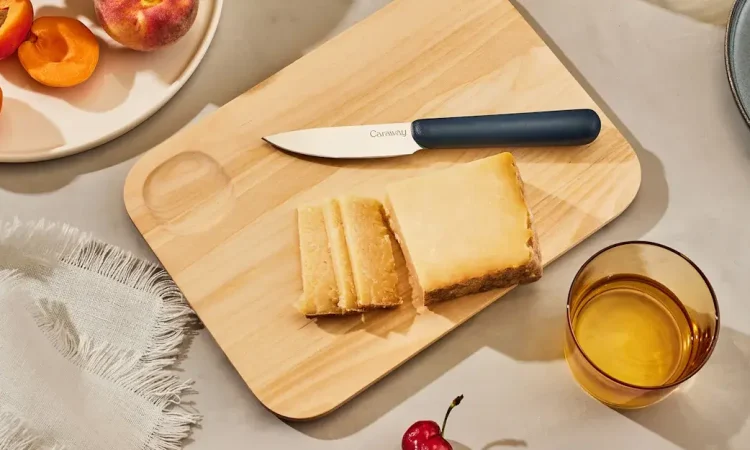
Choosing the best kitchen tools can transform your cooking experience, and one often overlooked but incredibly valuable tool is the cutting board scraper. Whether you’re a professional chef or a home cook, having the right scraper can simplify cleanup, improve hygiene, and add efficiency to your prep work. This guide will help you understand what to look for when choosing a cutting board scraper, from materials and size to durability and care tips.
Deconstructing a Cutting Board Scraper
Materials That Form the Ultimate Edge
The first thing you should pay attention to when choosing a cutting board scraper is the materials it is made of. When it comes to an ideal scraper, it should be made of durable yet gentle material that will not scratch the surface of your cutting board, such as wood, plastic, or bamboo.
Stainless steel is a popular choice because it’s extremely durable and easy to clean. However, while it’s ideal for tough ingredients, it can scratch softer surfaces like wood or composite boards. Silicone-based scrapers offer flexibility and are less likely to cause scratches, making them a great option for preserving your cutting board.
Another popular option is HDPE and polypropylene. These materials are strong and resistant to staining and odors, making them versatile for various types of food. They also help reduce the risk of cross-contamination by providing a non-porous surface that’s easy to sanitize.
Less commonly, you might find scrapers made of composite materials or recycled plastics, which can be both eco-friendly and functional. These are often designed with sustainability in mind and are gaining popularity among environmentally conscious consumers.
Form and Function: Determine What Fits Your Cooking Style
For straight-edge chopping boards, straight scrapers offer a simple, effective solution. If your cooking involves finely diced ingredients or garnishes, a scraper with a rounded edge is better suited for the task.
Handle design is another key consideration. A well-designed handle provides better control and comfort, especially during long prep sessions. For those handling large volumes of food, a wider scraper increases efficiency and reduces the number of passes needed to clear the surface. Matching your scraper to your cooking style makes it more than just a tool—it becomes a kitchen essential.
Also consider how the scraper interacts with other tools in your kitchen. Some scrapers come with edge notches for cutting dough or measuring guides to help with portioning. If you’re using it regularly for baking, these multi-functional features can save time and effort.
Why Size Counts: How to Determine the Right Size
The size of your scraper affects both its effectiveness and usability. Larger scrapers can cover more surface area, making them ideal for heavy-duty tasks and larger cutting boards. They’re great for professional chefs or home cooks preparing meals for a family.
Smaller scrapers, on the other hand, are perfect for delicate tasks like transferring finely chopped herbs or cleaning up tight spaces. Consider the size of your kitchen and your typical prep volume when choosing your cutting board scraper.
In some kitchens, it might even make sense to have multiple sizes on hand. A small scraper could be used for everyday tasks, while a large one could be reserved for big prep days or special recipes that require a lot of ingredients.
A Cutting Board Scraper: Why You Need One in Your Kitchen
Scrapers Are More Than Just Cleaning Tools
A cutting board scraper offers multiple benefits beyond basic cleanup. It can also act as a compost collector, dough divider, or ingredient transfer tool. By gathering peels and scraps efficiently, it keeps your workspace clean and reduces waste.
In baking, scrapers help with dough portioning and smoothing, and many are shaped to scrape the sides of bowls efficiently. These versatile applications make the cutting board scraper a must-have in any well-equipped kitchen.
Some specialized scrapers come with serrated edges for cleaning stubborn food residues or with angled blades that work well with rounded cutting boards or bowls. These design adaptations further extend the versatility of the scraper.
Food Safety and Hygiene Science
A cutting board scraper plays a crucial role in maintaining kitchen hygiene. It helps remove food residue that could harbor bacteria, particularly when working with raw meat or fish. Using a scraper instead of your hands or knife reduces the risk of cross-contamination.
Moreover, regular use of a scraper extends the life of your cutting board by preventing buildup of food particles that can lead to unpleasant odors and health hazards.
In professional kitchens, using color-coded scrapers can also help maintain hygiene standards by designating specific tools for different food types—red for raw meat, green for vegetables, blue for seafood, etc.
A Simple Godsend to Take Your Cooking Experience to New Heights
Though small, the scraper can significantly elevate your cooking. It streamlines ingredient transfers, minimizes cleanup, and enhances kitchen efficiency. By saving time on cleaning, you can focus more on the creative aspects of cooking.
A clean workspace also encourages better organization and mental clarity, allowing you to explore new techniques and recipes with confidence. A reliable scraper can quickly become your go-to tool in the kitchen.
Whether you’re preparing a complex meal or a simple salad, the ability to swiftly clear your cutting board and reset for the next step makes the cooking experience smoother and more enjoyable.
Best Features to Consider When Choosing a Cutting Board Scraper
Ergonomics: A Blend of Comfort and Utility
Comfort is crucial for tools used frequently. Choose a scraper with a contoured handle that fits well in your grip. A well-balanced scraper reduces wrist and hand fatigue, making it easier to use over extended periods.
Also, consider the tool’s weight. Heavier scrapers offer leverage for tougher debris, while lightweight ones provide better maneuverability. The right scraper should feel like an extension of your hand.
For individuals with arthritis or limited hand mobility, scrapers with padded or rubberized grips can offer additional comfort and usability, ensuring that everyone can benefit from this simple yet powerful kitchen tool.
Sturdy: The Indestructible Scraper
Durability is key. Look for scrapers made from high-quality materials with solid construction. Stainless steel is long-lasting but choose one that won’t bend easily. Silicone scrapers should be made from food-grade silicone that withstands heat and dishwashing.
Reading user reviews and checking product warranties can help you gauge how well a scraper holds up over time. A good investment ensures you won’t need a replacement anytime soon.
Even in high-use environments, such as commercial kitchens, a durable scraper can stand up to frequent use without showing signs of wear. Reinforced edges and seamless construction often indicate a better-quality tool.
Aesthetic Design: The Balance Between Visual Appeal and Functionality
A well-designed scraper should complement your kitchen both visually and functionally. From minimalist styles to vibrant, artistic designs, choose one that matches your aesthetic.
Look for added features like hanging holes, measurement markings, or textured grips. These small touches can enhance both storage convenience and utility, making your scraper a pleasure to use.
Some scrapers are part of coordinated kitchen sets and come in matching colors or materials that align with your other utensils, offering a cohesive look that enhances your cooking space.
How to Maintain Your Scraper to Extend Its Life
Cleaning Methods That Do Not Harm Your Scraper
Proper cleaning extends the life of your cutting board scraper. Stainless steel scrapers usually just need warm, soapy water. Avoid abrasive cleaners that can damage the surface. Silicone models are often dishwasher-safe and easy to sanitize.
Dry your scraper thoroughly after cleaning, especially if it’s made from wood or other porous materials. Storing a damp scraper can lead to mold and unpleasant odors.
Using a designated drying rack or hanging hook can help with proper air circulation, ensuring your scraper is always ready for the next use.
Why Common Mistakes Are What Shorten Lifespan
Avoid exposing scrapers to high heat, especially plastic or silicone ones, which can warp. Don’t misuse your scraper for cutting or prying; this can deform or break it.
Also, steer clear of harsh chemical cleaners, which can deteriorate the material over time. Stick to food-safe cleaning products to keep your scraper effective and safe.
Neglecting to clean your scraper right after use can also lead to buildup that becomes harder to remove over time. Prompt maintenance is key to longevity.
How to Know When It Is Time to Change Your Scraper
Even the best tools wear out. Signs it’s time to replace your scraper include cracked or misshapen edges, lingering smells, or visible stains that don’t come off with cleaning.
If your scraper no longer performs well—missing food debris or scraping ineffectively—it’s time for a new one. Keeping your tools in good shape ensures a safer, more efficient kitchen.
Be proactive: inspect your scraper monthly and evaluate its performance. Replacing a worn-out scraper promptly helps maintain kitchen hygiene and workflow.




